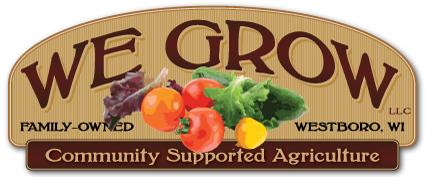In our house during the peak of tomato season, there is a pot of tomatoes cooking on the stove or stewing in the roaster nearly every day. Tomatoes grown in a field aren’t always perfect and who can possibly eat them all? Waste not, want not! Early in the season, when there aren’t a lot of tomatoes ripening at once, they are tossed in the freezer which opens up all sorts of options. Whole, frozen tomatoes in their simplest form can be used in chilis and soups during the cold winter months. Or we will pull them from the freezer in November or December when the garden slows down and we have more time. We also welcome the warmth in the house that time of year versus in August. Frozen tomatoes will easily shed their skins when run under warm water while still frozen. Then allowed to thaw in a colander, they will loose a majority of their water and take a very short time to cook into sauce recipes.
Enough tomato tips, here is our favorite tomato soup recipe. Make it your own by adding other veggies, making it chunky or adding your own fresh herbs to create a unique flavor. Please note that the finished product is NOT condensed soup, it is ready to serve without additional liquid.

Main Ingredients
- 14 lbs of tomatoes (approx) or 5 quarts of tomato juice
- 7 stalks of celery
- 2 green peppers
- 7 sprigs of parsley
- 4 medium-sized onions
- 3 large cloves garlic
- 2-4 bay leaves
- 10 cloves
Finishing Ingredients
- 1/2 lb butter
- 1 cup flour
- 1/2 to 1 cup sugar (adjust to your taste)
- 1 Tablespoon salt
Directions
Coarsely chop all ingredients and combine in a large stock pot or roaster. Bring mixture to a boil, then simmer for at least two hours. For naturally thicker soup, use paste varieties of tomatoes or simmer up to 6 hours.
Allow to cool down enough to work with and strain the mixture through a food mill or juice master to remove seeds, skins and stems. Prepare jars at this point of you plan to use a canning method of preservation.
PAUSE FOR AN IMPORTANT NOTE:
UW Extension tells us the safest thing to do at this point is to pressure can the vegetable mixture and add the roux ingredients to thicken the soup when you take it OUT of the jar at a later date. That said, I have been doing it the unsafe way for my entire adult life without any problems to date. Do your research and preserve food at your own risk. Review their recommendations here >>
RESUME RECIPE:
In a large pot, melt butter over medium-high heat then whisk in flour until completely incorporated and all lumps are removed as you would when creating a roux. Add your strained tomato mixture back to the pot, along with the sugar and salt and bring to a boil stirring often to prevent burning to the pot. Taste test for sugar and salt balance. It is now ready to preserve.
*The safest method is to freeze the soup. However, we use the pressure canning method: 11 lbs for 15 minutes at our 0′-1,000′ elevation. I have seen methods using a water bath, but I often add carrots, zucchinis, cucumbers and squash which lowers the acidity to an unpredictable level, so it not recommended. I have also had soup jars unseal several weeks later when I tried the water bath method.
Every batch will taste different. Using all cherry tomatoes will render a completely different flavor than using all beefsteaks. We have also made this soup with yellow pear and roma tomatoes and it turned out fantastic, but we only needed 1/4 cup of sugar because they are so sweet. Yellow tomatoes are very low-acid, so keep this in mind when choosing a preservation method. We find the best flavor is using a variety of tomatoes and combining them for a rich, robust flavor.
*Please note that it is recommended to NOT can foods that contain flour. Please do you research before using our recipe. All methods are done at your own risk.













